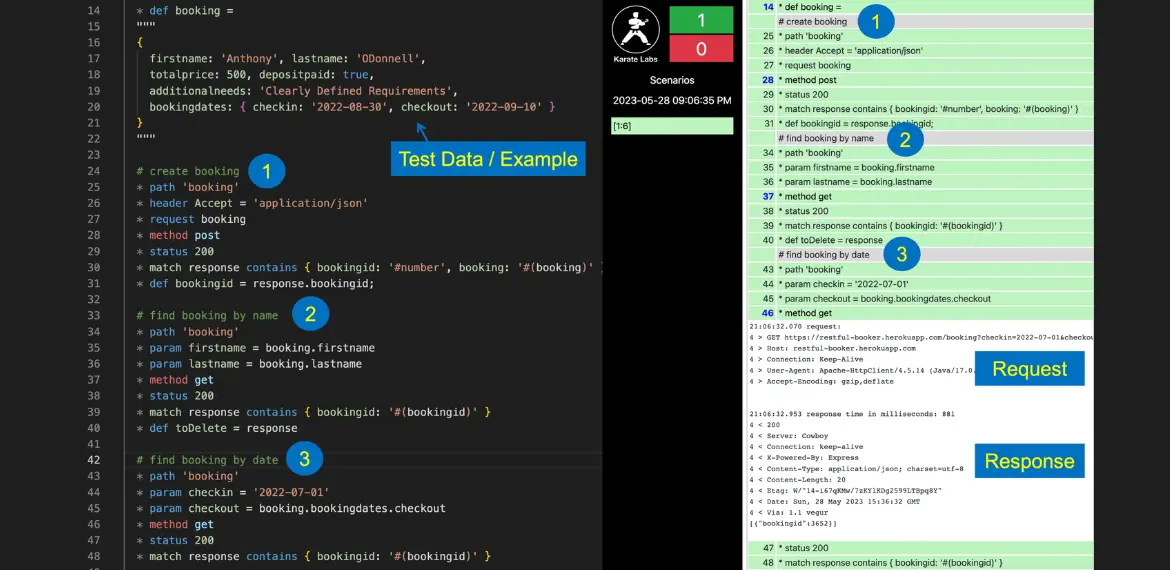Unlocking Developers’ Full-Potential: How Well-Written API Documentation Drives Success

Are you tired of the frustration that comes with deciphering poorly written API documentation? Are you struggling to integrate APIs into your projects because of unclear instructions? If so, it's time to enhance your developer experience and take your development journey to the next level!
In this blog, we will explore the transformative power of well-written API documentation. Find out how clear and intuitive API documentation can speed up your onboarding process, making it easier to understand and use APIs effectively. Learn how comprehensive and accurate content can promote efficiency and collaboration, allowing you to work seamlessly with APIs.
The Developer's Perspective: Challenges and Needs
From a developer's perspective, working with APIs can be both exciting and challenging. APIs, serve as the means for different software systems to communicate and interact with one another seamlessly. It's like a language that allows different programs to understand and work with each other effectively.
Now, let's understand into the challenges and needs that developers encounter when dealing with APIs.
Challenges
- Complex Functionalities:
APIs are designed to be powerful tools, offering a wide range of functionalities that can significantly enhance the capabilities of applications. However, this strength can also challenge developers, especially those new to the API. Understanding the nuances of each functionality and knowing how to use them appropriately can be overwhelming. Developers may need help with complex concepts, slowing their development process and leading to potential errors.
- Diverse Endpoints:
Endpoints are specific URLs within an API that developers use to send requests for particular actions or data. APIs often have numerous endpoints, each catering to different functionalities. Keeping track of all these endpoints and understanding when to use each can be confusing, especially in APIs with many endpoints. This challenge may arise when developers try to achieve specific tasks or extract specific data from the API.
- API Evolution:
APIs are not static entities; they undergo continuous improvement and development. API providers release new versions of their APIs to introduce new features, fix bugs, or enhance performance. However, older versions might be deprecated with these updates, meaning they are no longer supported and will eventually become obsolete. Developers must keep up with these changes to ensure their applications are built on the API's latest and most stable version.
Needs
- Clear and Concise Documentation:
Given the complexity of APIs, developers rely heavily on clear and concise documentation to understand how to interact with the API effectively. Well-written documentation should comprehensively explain the API's functionalities, including each endpoint's purpose and expected behavior. It should also outline the required parameters, possible responses, and detailed explanations of error messages.
- Comprehensible Examples:
Developers greatly benefit from api documentation examples that demonstrate real-world use cases of the API. These examples show them how to construct requests, handle responses, and deal with various scenarios that may arise during integration.
- Easy Access to Information:
When developers are working on a project, they often need quick access to specific details of the API. This includes endpoint details, parameter descriptions, and guidance on structuring requests and interpreting responses. Well-organized and easily navigable documentation enables developers to find the information they need swiftly, saving valuable time and reducing frustration.
- Guidance on Best Practices:
API documentation should go beyond providing basic information. It should also offer guidance on best practices for using the API effectively. This includes tips on optimizing requests for better performance, handling errors gracefully, and any other recommendations that can lead to more efficient and reliable applications.
- Updated Documentation:
As APIs evolve, the documentation must also keep pace with the changes. API providers should ensure their documentation is up-to-date with the latest API version. Clear versioning information should be provided, so developers know of any changes that might affect their applications.
The Impact of Well-Written API Documentation on Developer Success
Well-written API documentation profoundly impacts developers' success, enabling them to accomplish their tasks more efficiently and effectively. Let's explore how such documentation accelerates onboarding, promotes efficiency and productivity, fosters collaboration and innovation, and enhances code quality while reducing errors.
Accelerating the Onboarding Process
The onboarding process can be intimidating for developers when they are introduced to a new API. Well-structured and clear documentation acts as a welcoming guide, swiftly introducing developers to the functionalities and capabilities of the API. With easy-to-understand tutorials and illustrative API documentation examples, developers can quickly grasp the key concepts and integrate the API into their projects. This accelerated onboarding allows developers to become proficient users quickly, saving them from unnecessary struggles and delays.
Promoting Efficiency and Productivity
Comprehensive and concise API documentation is crucial in saving developers from the burden of guessing how to interact with the API effectively. When detailed explanations and real-world use cases are provided, developers can seamlessly integrate the API into their code without wasting time deciphering vague instructions. This clarity empowers them to concentrate on crafting robust applications rather than getting stuck in troubleshooting errors caused by unclear guidance. As a result, development cycles become more efficient, leading to quicker delivery of software solutions.
Fostering Collaboration and Innovation
APIs often act as bridges that connect different teams within an organization. When API documentation is well-written and accessible, it enhances communication and collaboration among developers, product managers, and other stakeholders. Developers can clearly understand the capabilities and limitations of the API, enabling them to contribute more effectively to the overall development process. This seamless exchange of information sparks creativity and innovation, creating novel and groundbreaking applications.
Enhancing Code Quality and Reducing Errors
One of the most significant benefits of well-written API documentation is improved code quality and reduced errors. When developers clearly understand how to use the API correctly, they are less likely to make mistakes during implementation. Additionally, comprehensive documentation often includes best practices and guidelines that promote better coding practices. These guidelines help developers write more maintainable and bug-free code, increasing application stability and reliability.
Essential Elements of Effective API Documentation
Developers greatly benefit from well-crafted API documentation, enabling them to utilize APIs in their projects seamlessly. To achieve this, several important factors must be considered to ensure clarity and ease of integration.
Clear and Intuitive Structure
One crucial aspect is the organization of the documentation. A user-friendly structure with clear headings and subheadings is essential. This logical categorization helps developers navigate the documentation effortlessly, preventing them from getting lost in technical jargon. Including a table of contents also aids quick reference, and a user-friendly search function further enhances accessibility. A well-organized API documentation becomes a reliable resource for developers, facilitating efficient interaction with the API.
Comprehensive and Accurate Content
To ensure comprehensive understanding, API documentation should leave no room for ambiguity. This means exhaustively explaining every endpoint, parameter, and response. Providing real-world use case examples adds context and illustrates how the API can be effectively applied in practical scenarios. Thoroughly covering all aspects of the documentation instills confidence in developers, enabling them to make the most of the API's capabilities and align it effectively with their specific project requirements.
Integration and SDK Documentation
API documentation should include integration guides and Software Development Kits (SDKs) to facilitate smooth integration across various platforms and programming languages. These resources offer step-by-step instructions, code snippets, and libraries that simplify the implementation process. Integration and SDK documentation act as valuable companions, enabling developers to incorporate the API into their applications without unnecessary hurdles seamlessly.
Best Practices for Writing Exceptional API Documentation
Writing exceptional API handbook requires adherence to several best practices prioritizing clarity, usability, and comprehensiveness. Follow the guidelines below to create documentation that empowers users and enhances the overall developer experience.
- Understanding the Target Audience:
Before we start with the writing process, it's essential to consider the users of the API documentation. Developers vary in experience and technical knowledge, so it's important to customize the documentation to cater to their needs. This ensures that the information provided is easily understandable and applicable to them. For beginners, include introductory sections that offer a gentle introduction to the topic, while for experienced developers, provide more comprehensive technical details. This will help create documentation that effectively addresses their unique challenges and queries.
- Consistency in Style and Formatting:
Maintaining consistency in style and formatting is crucial in ensuring a professional and polished appearance throughout the documentation. It's important to adopt a consistent tone of voice, employ clear language, and implement a uniform structure for all sections. This approach facilitates easy navigation and helps users quickly find the necessary information. In addition to textual consistency, it's equally vital to maintain uniformity in code formatting and syntax highlighting. Doing so significantly improves the readability and comprehension of the code snippets provided. When the documentation adheres to a unified style, developers can concentrate on grasping the content rather than being distracted by deciphering different presentation styles. This ultimately enhances the overall user experience and makes the documentation more effective in conveying the intended message.
- Gathering and Incorporating User Feedback:
API documentation should be a collaborative effort with the developer community. Seek user feedback to identify pain points, confusion, or missing information. Offer channels for users to provide feedback, such as forums, chat support, or email. Review and analyze the feedback regularly to identify patterns and address common concerns. Incorporate user suggestions and update the documentation's usability and accuracy.
Gathering and Incorporating User Feedback
In the process of creating top-notch API guide that genuinely meets developers' needs, gathering and incorporating user feedback plays a crucial role. It involves actively seeking input from developers who work with the API and leveraging their valuable insights to improve the documentation.
To get started, you can encourage developers to share their feedback through online surveys, forums, or direct email communication. Listen attentively to their experiences, challenges, and suggestions, valuing the significance of their perspectives.
Once you have collected the feedback, carefully analyze it to identify common patterns and recurring issues. Pay close attention to areas that developers find confusing or unclear and the challenges they encounter during integration. This analysis will help you prioritize the most critical areas for improvement.
Next, take action on the feedback by integrating the suggested changes and updates into the API handbook. Address the identified issues, explain further, and offer additional examples to enhance clarity and understanding.
Elevate Your API Documentation with KarateLabs
A well-crafted API documentation plays a vital role in fostering developer success. It is important to have sound knowledge about developers' challenges and needs. It also include the knowledge of the essential elements and best practices discussed above, which allows you to create documentation that accelerates onboarding, enhances productivity, fosters collaboration, and improves code quality.
If you aim to elevate your API documentation to new heights, Karate Labs is the right place. Karate Labs is an innovative platform designed to streamline creating and maintaining comprehensive API documentation. Featuring a user-friendly interface and robust features, we empowers developers to write and manage their documentation effortlessly.
With this cutting-edge solution, you can unleash the full potential of your API and maximize developer success. Level up your API documentation with ease - Try Karate Labs today!






